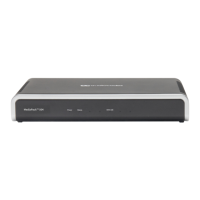SIP User's Manual 278 Document #: LTRT-65415
MediaPack Series
8. In the 'IP to Hunt Group Routing Table' page, configure that INVITEs with "ITSP1" as
the hostname in the From URI are routed to Hunt Group #1, and INVITEs with "ITSP2"
as the hostname in the From URI are routed to Hunt Group #2. In addition, configure
calls received from ITSP1 as associated with IP Group #1.
Figure 8-28: Configuring ITSP-to-Hunt Group Routing
9. In the 'Tel to IP Routing' page, configure Tel-to-IP routing rules for calls from Hunt
Group #1 to IP Group #1, and from Hunt Group #2 to IP Group #2.
Figure 8-29: Configuring Hunt Group to ITSP Routing
8.2.9 Mapping PSTN Release Cause to SIP Response
The device's FXO interface interoperates between the SIP network and the PSTN/PBX.
This interoperability includes the mapping of PSTN/PBX Call Progress Tones to SIP 4xx or
5xx responses for IP-to-Tel calls. The converse is also true - for Tel-to-IP calls, the SIP 4xx
or 5xx responses are mapped to tones played to the PSTN/PBX.
When establishing an IP-to-Tel call, the following rules are applied:
If the remote party (PSTN/PBX) is busy and the FXO device detects a Busy tone, it
sends a SIP 486 Busy response to IP. If it detects a Reorder tone, it sends a SIP 404
Not Found (no route to destination) to IP. In both cases, the call is released. Note that
if the parameter DisconnectOnBusyTone is set to 0, the FXO device ignores the
detection of Busy/Reorder tones and doesn’t release the call.
For all other FXS/FXO release types (caused when there are no free channels in the
specific Hunt Group), or when an appropriate rule for routing the call to a Hunt Group
doesn’t exist, or if the phone number isn’t found), the device sends a SIP response (to
IP) according to the parameter DefaultReleaseCause. This parameter defines Q.931
release causes. Its default value is ‘3’, which is mapped to the SIP 404 response. By
changing its value to ‘34’, the SIP 503 response is sent. Other causes can be used as
well.
8.2.10 Querying Device Channel Resources using SIP OPTIONS
The device reports its maximum and available channel resources in SIP 200 OK responses
upon receipt of SIP OPTIONS messages. The device sends this information in the SIP X-
Resources header with the following parameters:
telchs: specifies the total telephone channels as well as the number of free (available)
telephone channels
mediachs: not applicable
Below is an example of the X-Resources:
X-Resources: telchs= 8/4;mediachs=0/0
In the example above, "telchs" specifies the number of available channels and the number
of occupied channels (4 channels are occupied and 8 channels are available).

